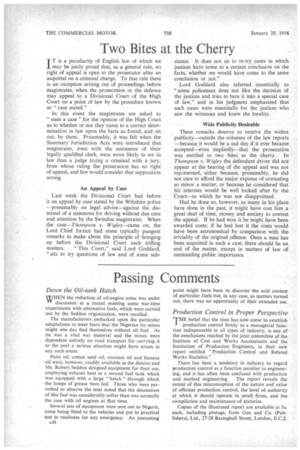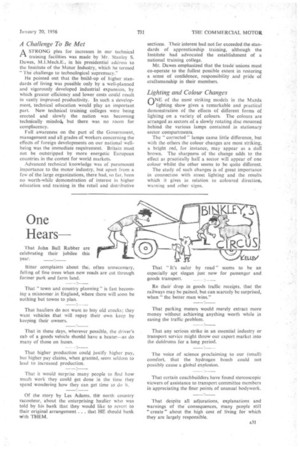Passing Comments
Page 32

Page 33

If you've noticed an error in this article please click here to report it so we can fix it.
Down the Oil-tank Hatch
WHEN the reduction of oil-engine noise was under TV discussion at a recent meeting some war-time experiments with alternative fuels, which were carried out by the Seddon organization, were recalled.
The manufacturers embarked upon the particular adaptations to meet fears that the Nigerian tin mines might one day find themselves without oil fuel. As tin was a vital war material and the mines were dependent entirely on road transport for carrying it to the port a serious situation might have arisen in any such event.
Palm oil, cotton seed oil, coconut oil and banana oil were, however, readily available in the district and Mr. Robert Seddon designed equipment for their use, employing exhaust heat in a second fuel tank which was equipped with a large " hatch " through which the lumps of grease were fed. Those who were permitted to observe the tests noted that the detonation of this fuel was considerably softer than was normally the case with oil engines at that time.
Several sets of equipment were sent out to Nigeria, some being fitted to the vehicles and put to practical test in readiness for any emergency. An interesting A30 point might have been to discover the acid content of particular fuels but, in any case, as matters turned out, there was no opportunity of their extended use.
Production Control in Proper Perspective
1HE belief that the time has now come to establish production control firmly as a managerial function indispensable in all types of industry, is one of the conclusions reached by the joint committee of the Institute of Cost and Works Accountants and the Institution of Production Engineers, in their new report entitled "Production Control and Related Works Statistics."
There has been a tendency in industry to regard production control as a function peculiar to engineering, and it has often been confused with production and method engineering. The report reveals the extent of this misconception of the nature and value of efficient production control, the level of authority at which it should operate in small firms, and the compilation and maintenance of statistics.
Copies of the illustrated report are available at 5s. each, including postage, from Gee and Co. (Publishers), Ltd., 27-28 Basinghall Street, London, E.C.2.
A -Challenge To Be Met
ASTRONG plea for increases in our technical
training facilities was made by Mr. Stanley S. Dawes, M.I.Mech.E., in his presidential address •to the Institute of the Motor Industry, which he termed "The challenge to technological supremacy."
He pointed out that the build-up of higher standards of living was possible only by a well-planned and vigorously developed industrial expansion, by which greater efficiency and lower costs ccaild result in vastly improved productivity. In such a development, technical education would play an important part. New technical training colleges were being erected and slowly the nation was becoming technically minded. but there was no room for complacency.
Full awareness on the part of the Government, management and all grades of workers concerning the effects of foreign developments on our national wellbeing was the immediate requirement. Britain must not be outstripped by more energetic European countries in the contest for world markets.
Advanced technical knowledge was of paramount importance to the matchindustry, but apart from a few of the large organizations, there had, so far, been no worth-while demonstration of interest in higher education and training in the retail and distributive sections. Their interest had not far exceeded the standards of apprenticeship training, although the Institute had advocated the establishment of a national training college.
Mr. Dawes .emphasized that the trade.union § must co-operate to the fullest possible extent in restoring a sense of confidence, responsibility and pride of craftsmanship in their members.
Lighting and Colour Changes
ONE of the most striking models in the Mazda
lighting show gives a remarkable and practical demonstration of the effects of different forms of lighting on a variety of colours. The colours are arranged as sectors of a slowly rotating disc mounted behind the various lamps contained in stationary sector compartments.
The " corrected -" lamps cause little difference, hut with the others the colour changes are most striking, a bright red, for instance, may appear as a dull brown. The sharpness of the change adds to the effect as practically half a sector will appear of one colour whilst the other seems to be quite different.
The study of such changes is of great importance in connection with street lighting and the results which it gives in relation to coloured direction, warning and other signs.




































































































